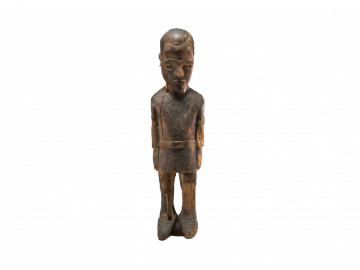The Balot NFT puts digital ownership of culture back into the hands of the many and helps buy back land once stolen. In a radical new model of restitution, NFT technology becomes a tool for decolonization.
For centuries people on plantations in Congo and elsewhere have been deprived of their culture and forced into unpaid labor, supporting wealth and art in the global north. In this case of digital restitution, the Congolese Plantation Workers Art League (CATPC) claims their heritage using the magic powers of NFTs. The Balot sculpture was carved in 1931, during a Pende uprising against atrocities carried out by the Unilever plantation system and Belgian colonial agents. The sculpture depicts the angry spirit of beheaded Belgian officer Maximilien Balot. It was made to control Balot’s spirit and make him work for the Pende people.
Today, the sculpture is held in the Virginia Museum of Fine Arts (VMFA) in Richmond. Loan requests by CATPC have thus far been futile. With the Balot NFT, CATPC claims back what is theirs: not just art, but land. CATPC has publicly called back the powers of the Balot sculpture by minting it as NFT. With its sales, CATPC buys back land in one of the most impoverished areas of the world, replants the forest and reintroduces biodiversity.
Buyers get a digital rendering of the Balot sculpture hovering over a fragment of a drawing by CATPC member Ced'art Tamasala. The drawing maps out global value flows of capital, commodities and cultural exploitation. It exhibits how the Balot sculpture was carved to resist these unequal power relations and its disastrous consequences for the community.
The drawing has been divided in 306 pieces, over each of which the digital Balot hovers. With each NFT sold, CATPC can buy back one hectare of land.



















